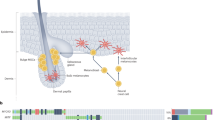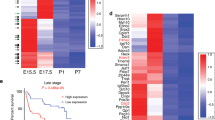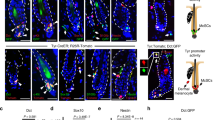Abstract
The aggressive clinical behavior of melanoma suggests that the developmental origins of melanocytes in the neural crest might be relevant to their metastatic propensity. Here we show that primary human melanocytes, transformed using a specific set of introduced genes, form melanomas that frequently metastasize to multiple secondary sites, whereas human fibroblasts and epithelial cells transformed using an identical set of genes generate primary tumors that rarely do so. Notably, these melanomas have a metastasis spectrum similar to that observed in humans with melanoma. These observations indicate that part of the metastatic proclivity of melanoma is attributable to lineage-specific factors expressed in melanocytes and not in other cell types analyzed. Analysis of microarray data from human nevi shows that the expression pattern of Slug, a master regulator of neural crest cell specification and migration, correlates with those of other genes that are important for neural crest cell migrations during development. Moreover, Slug is required for the metastasis of the transformed melanoma cells. These findings indicate that melanocyte-specific factors present before neoplastic transformation can have a pivotal role in governing melanoma progression.
This is a preview of subscription content, access via your institution
Access options
Subscribe to this journal
Receive 12 print issues and online access
$209.00 per year
only $17.42 per issue
Buy this article
- Purchase on Springer Link
- Instant access to full article PDF
Prices may be subject to local taxes which are calculated during checkout




Similar content being viewed by others
References
Lens, M.B. & Dawes, M. Global perspectives of contemporary epidemiological trends of cutaneous malignant melanoma. Br. J. Dermatol. 150, 179–185 (2004).
Beddingfield, F.C., III. The melanoma epidemic: res ipsa loquitur . Oncologist 8, 459–465 (2003).
Bartkova, J. et al. The p16-cyclin D/Cdk4-pRb pathway as a functional unit frequently altered in melanoma pathogenesis. Cancer Res. 56, 5475–5483 (1996).
Omholt, K., Platz, A., Kanter, L., Ringborg, U. & Hansson, J. NRAS and BRAF mutations arise early during melanoma pathogenesis and are preserved throughout tumor progression. Clin. Cancer Res. 9, 6483–6488 (2003).
Chin, L. The genetics of malignant melanoma: lessons from mouse and man. Nat. Rev. Cancer 3, 559–570 (2003).
Tietze, M.K. & Chin, L. Murine models of malignant melanoma. Mol. Med. Today 6, 408–410 (2000).
Shaw, H.M., McCarthy, W.H., McCarthy, S.W. & Milton, G.W. Thin malignant melanomas and recurrence potential. Arch. Surg. 122, 1147–1150 (1987).
Corsetti, R.L., Allen, H.M. & Wanebo, H.J. Thin < or = 1 mm level III and IV melanomas are higher risk lesions for regional failure and warrant sentinel lymph node biopsy. Ann. Surg. Oncol. 7, 456–460 (2000).
Bedrosian, I. et al. Incidence of sentinel node metastasis in patients with thin primary melanoma (< or = 1 mm) with vertical growth phase. Ann. Surg. Oncol. 7, 262–267 (2000).
Nesbit, M.S.V. & Herlyn, M. Biology of melanocytes and melanoma. in Cutaneous Melanoma (eds. Balch, C. et al.) 463 (Quality Medical, St. Louis, 1998).
Bronner-Fraser, M. Neural crest cell migration in the developing embryo. Trends Cell Biol. 3, 392–397 (1993).
Hahn, W.C. et al. Creation of human tumour cells with defined genetic elements. Nature 400, 464–468 (1999).
Elenbaas, B. et al. Human breast cancer cells generated by oncogenic transformation of primary mammary epithelial cells. Genes Dev. 15, 50–65 (2001).
Lundberg, A.S. et al. Immortalization and transformation of primary human airway epithelial cells by gene transfer. Oncogene 21, 4577–4586 (2002).
Rich, J.N. et al. A genetically tractable model of human glioma formation. Cancer Res. 61, 3556–3560 (2001).
Li, G. et al. Downregulation of E-cadherin and Desmoglein 1 by autocrine hepatocyte growth factor during melanoma development. Oncogene 20, 8125–8135 (2001).
Cruz, J., Reis-Filho, J.S., Silva, P. & Lopes, J.M. Expression of c-met tyrosine kinase receptor is biologically and prognostically relevant for primary cutaneous malignant melanomas. Oncology 65, 72–82 (2003).
Natali, P.G. et al. Expression of the c-Met/HGF receptor in human melanocytic neoplasms: demonstration of the relationship to malignant melanoma tumour progression. Br. J. Cancer 68, 746–750 (1993).
Giordano, S., Ponzetto, C., Di Renzo, M.F., Cooper, C.S. & Comoglio, P.M. Tyrosine kinase receptor indistinguishable from the c-met protein. Nature 339, 155–156 (1989).
Phillips, D.L., Benner, K.G., Keeffe, E.B. & Traweek, S.T. Isolated metastasis to small bowel from anaplastic thyroid carcinoma. With a review of extra-abdominal malignancies that spread to the bowel. J. Clin. Gastroenterol. 9, 563–567 (1987).
Elsayed, A.M., Albahra, M., Nzeako, U.C. & Sobin, L.H. Malignant melanomas in the small intestine: a study of 103 patients. Am. J. Gastroenterol. 91, 1001–1006 (1996).
Southern, E.M. Detection of specific sequences among DNA fragments separated by gel electrophoresis. J. Mol. Biol. 98, 503–517 (1975).
Hajra, K.M., Chen, D.Y. & Fearon, E.R. The SLUG zinc-finger protein represses E-cadherin in breast cancer. Cancer Res. 62, 1613–1618 (2002).
LaBonne, C. & Bronner-Fraser, M. Snail-related transcriptional repressors are required in Xenopus for both the induction of the neural crest and its subsequent migration. Dev. Biol. 221, 195–205 (2000).
Lee, H.O., Levorse, J.M. & Shin, M.K. The endothelin receptor-B is required for the migration of neural crest-derived melanocyte and enteric neuron precursors. Dev. Biol. 259, 162–175 (2003).
Ikeda, K. et al. Expression of CD44H in the cells of neural crest origin in peripheral nervous system. Neuroreport 7, 1713–1716 (1996).
Britsch, S. et al. The ErbB2 and ErbB3 receptors and their ligand, neuregulin-1, are essential for development of the sympathetic nervous system. Genes Dev. 12, 1825–1836 (1998).
Carl, T.F., Dufton, C., Hanken, J. & Klymkowsky, M.W. Inhibition of neural crest migration in Xenopus using antisense slug RNA. Dev. Biol. 213, 101–115 (1999).
Subramony, C. & Lewin, J.R. Nevus cells within lymph nodes. Possible metastases from a benign intradermal nevus. Am. J. Clin. Pathol. 84, 220–223 (1985).
Bortolani, A., Barisoni, D. & Scomazzoni, G. Benign “metastatic” cellular blue nevus. Ann. Plast. Surg. 33, 426–431 (1994).
Johnson, W.T. & Helwig, E.B. Benign nevus cells in the capsule of lymph nodes. Cancer 23, 747–753 (1969).
Morgenstern, J.P. & Land, H. Advanced mammalian gene transfer: high titre retroviral vectors with multiple drug selection markers and a complementary helper-free packaging cell line. Nucleic Acids Res. 18, 3587–3596 (1990).
Counter, C.M. et al. Dissociation among in vitro telomerase activity, telomere maintenance, and cellular immortalization. Proc. Natl. Acad. Sci. USA 95, 14723–14728 (1998).
Stewart, S.A. et al. Lentivirus-delivered stable gene silencing by RNAi in primary cells. RNA 9, 493–501 (2003).
Cifone, M.A. & Fidler, I.J. Correlation of patterns of anchorage-independent growth with in vivo behavior of cells from a murine fibrosarcoma. Proc. Natl. Acad. Sci. USA 77, 1039–1043 (1980).
Kuperwasser, C. et al. Development of spontaneous mammary tumors in BALB/c p53 heterozygous mice. A model for Li-Fraumeni syndrome. Am. J. Pathol. 157, 2151–2159 (2000).
Hodgson, G. et al. Genome scanning with array CGH delineates regional alterations in mouse islet carcinomas. Nat. Genet. 29, 459–464 (2001).
Snijders, A.M. et al. Shaping of tumor and drug-resistant genomes by instability and selection. Oncogene 22, 4370–4379 (2003).
Jain, A.N. et al. Fully automatic quantification of microarray image data. Genome Res. 12, 325–332 (2002).
Kuperwasser, C., Pinkas, J., Hurlbut, G.D., Naber, S.P. & Jerry, D.J. Cytoplasmic sequestration and functional repression of p53 in the mammary epithelium is reversed by hormonal treatment. Cancer Res. 60, 2723–2729 (2000).
Petersen, S.L., Gardner, E., Adelman, J. & McCrone, S. Examination of steroid-induced changes in LHRH gene transcription using 33P-and 35S-labeled probes specific for intron 2. Endocrinology 137, 234–239 (1996).
Golub, T.R. et al. Molecular classification of cancer: class discovery and class prediction by gene expression monitoring. Science 286, 531–537 (1999).
Acknowledgements
We thank S. Dessain, H. Vaziri, P.A. Sharp, G. Gupta, S. Stewart, W. Hahn, A. Orimo, S. Godar, I. Ben-porath, J. Yang and T. Onder for discussions and suggestions during the course of this work; T. Golub for discussions regarding microarray experiments; T. Chavarria for assistance with animal husbandry; and D. LaCivita for primary melanocyte isolation. P.B.G. is supported by a US Army Pre-doctoral Breast Cancer Fellowship. This work was supported by a grant from the US National Institutes of Health and National Cancer Institute (R.A.W.). R.A.W. is an American Cancer Society Research Professor and a Daniel K. Ludwig Foundation Cancer Research Professor.
Author information
Authors and Affiliations
Corresponding author
Ethics declarations
Competing interests
The authors declare no competing financial interests.
Supplementary information
Supplementary Fig. 1
Immunohistochemical characterization of Mel-STR lung metastases. (PDF 1078 kb)
Supplementary Fig. 2
Immunohistochemical characterization of subcutaneous Mel-STR tumors. (PDF 2363 kb)
Supplementary Fig. 3
Gross appearance of Mel-STR metastasis-laden organs. (PDF 4296 kb)
Supplementary Table 1
Genes significantly correlated in their expression patterns with Slug in human nevus samples (p<0.05). (PDF 106 kb)
Rights and permissions
About this article
Cite this article
Gupta, P., Kuperwasser, C., Brunet, JP. et al. The melanocyte differentiation program predisposes to metastasis after neoplastic transformation. Nat Genet 37, 1047–1054 (2005). https://doi.org/10.1038/ng1634
Received:
Accepted:
Published:
Issue Date:
DOI: https://doi.org/10.1038/ng1634
This article is cited by
-
The epithelial–mesenchymal plasticity landscape: principles of design and mechanisms of regulation
Nature Reviews Genetics (2023)
-
Inactivation of the Hippo tumor suppressor pathway promotes melanoma
Nature Communications (2022)
-
Sox2 is necessary for androgen ablation-induced neuroendocrine differentiation from Pten null Sca-1+ prostate luminal cells
Oncogene (2021)
-
Human melanocyte development and melanoma dedifferentiation at single-cell resolution
Nature Cell Biology (2021)
-
IER2-induced senescence drives melanoma invasion through osteopontin
Oncogene (2021)



